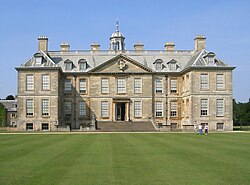Servants' quarters

Servants' quarters are those parts of a building, traditionally in a private house, which contain the domestic offices and staff accommodation. From the late 17th century until the late 19th/early 20th century they were a common feature in many large houses.
Servants' Quarters Media
At 16th century Hampton Court the lesser courtyard forms part of a formal processional route to the grander areas of the palace.
By 1688, the smaller window sizes of the lowest and uppermost floors of Belton House show early signs that servants were confined to delegated areas. The servants enjoyed the same view from the front of the house as their employers.
The Baroque architecture of Castle Howard allowed the massive servants' areas, on the right and left of the picture, to be highly visible and on an architectural par with the corps de logis itself
Holkham Hall: D represents the principal dining room where a disguised door in the classical apse, gives access to long route via stairs and passages by which the food reached the dining room from the distant kitchen in the service wing (bottom right) When dining alone en famille the owners ate in the family wing (top right) even further from the kitchen
Staff call bells, attached to bell pulls in various rooms
The neat Neoclassical lines of Castle Coole, a picturesque idyll unspoilt by any hint of the servants who were in fact toiling, out of sight, underground
At 19th century Mentmore Towers, the blind outer walls of the service wing are barely visible, behind trees and banks, on the right of the building. The sevants' wing is actually, of near similar size to the main block but so designed that only the uppermost floor is visible from the exterior of the mansion






